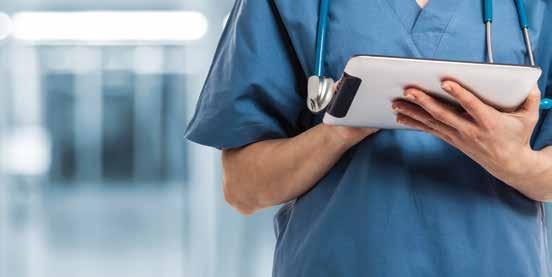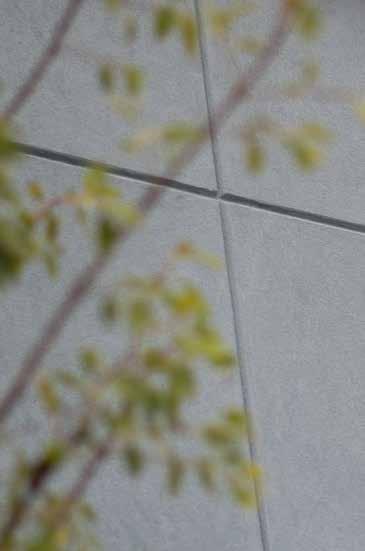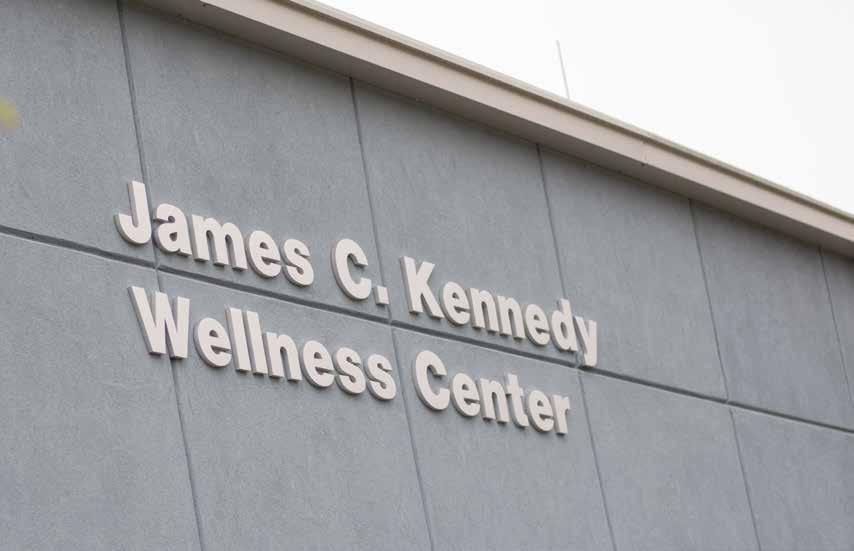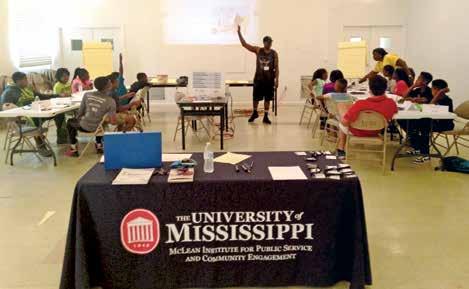
7 minute read
Edy Dingus finds meaning as United Way VISTA

Chris Beard
Advertisement
CEED alumnus strives to increase access to quality health care in rural Mississippi
Chris Beard arrived at the University of Mississippi in fall 2014 to study biochemistry. He had just graduated from Northeast Mississippi Community College and was already developing a plan to pursue his dream of practicing medicine someday. When he joined the McLean Institute’s Catalyzing Entrepreneurship and Economic Development initiative, or CEED, in 2014, Beard brought with him a strong passion for improving health outcomes in rural Mississippi. This commitment was based, in part, on his experiences volunteering at the Agape free health clinic in New Albany.
Beard is now in his fourth year of medical school, and he intends to apply for internal medicine residencies in the following year. He will also be marrying his fiancée next year, and upon finishing his training he hopes to return to the state of Mississippi to practice medicine. This enduring dedication to improving Mississippi health outcomes has roots in Beard’s involvement with the CEED initiative.
While serving as a CEED innovation scholar, Beard furthered his goal of improving health care access to rural communities by designing the Mississippi Rural Health Initiative pilot program. In addition to improving health care access and quality, the initiative sought to engage local health care workers, entrepreneurs and community leaders of all ages to better understand the role telehealth systems can serve in their communities.
Telehealth allows doctors and patients to connect via videoconference, which ensures that distance is not a barrier to receiving quality health care.
Beard learned that this technology was being used by Tallahatchie General Hospital in Charleston and believed its model could be expanded to other hospitals and health care facilities in the state. The Mississippi Rural Health Initiative also addressed a need for telehealth in schools. Beard believed that the presence of telehealth in a classroom could facilitate interactions among students, doctors and nurses that could inspire students to pursue careers in the health care field. In addition to increasing the number of patients served by telemedicine, Beard also identified a need to improve the physical premises of rural health facilities. Again, Tallahatchie General Hospital served as an excellent model for Beard’s initiative as it had been recently renovated.
Beard was able to spend his 2015 summer internship with the CEED initiative immersed in the health care field. He participated in the Physician

Shadowing Program at North Mississippi Medical Center in Tupelo and attended the Rural Health Conference at UMMC. Both experiences improved his model initiative.
“Students such as Beard take full advantage of the opportunities for discovery, innovation and networking that are provided by CEED and immeasurably enhance the work of the McLean Institute,” said JR Love, CEED project manager.
However, the state of Mississippi is the ultimate beneficiary when a committed student such as Beard obtains firsthand knowledge of community and economic development through CEED. Thanks to his ability to merge an understanding of entrepreneurship with innovations in the health care field, Beard stands ready to have a positive influence on health outcomes in his home state for the duration of his career. n
Community Partner Spotlight: Catherine Moring

For four consecutive years, University of Mississippi students served in Charleston, Mississippi, thanks to Catherine Moring (PhD ’13), executive director of the James C. Kennedy Wellness Center and a McLean Institute board member. Kate Sackett and Audrey Dayan, both Catalyzing Entrepreneurship and Economic Development, or CEED, innovation scholars, were summer interns in 2015, 2016, 2017 and 2018, completing their internships thanks to a wonderful community partner. These internships provide Tallahatchie General Hospital and the James C. Kennedy Wellness Center the ability to conduct research to better facilitate and administer programs. Why did you select Charleston as the location for your project?
I did not select Charleston, Charleston chose me. When the Robert Wood Johnson Foundation county health rankings were first released, Tallahatchie County was ranked 81st of 82 counties in Mississippi. It was ranked just above the least healthy county, in what was at the time the least healthy state in the nation. This was very alarming and raised the concern of numerous Charleston residents. Through a local nonprofit organization, the Charleston Arts and Revitalization Effort (CARE), and by way of Dr. Ed Meek, I was asked to help the community address their needs and health concerns. I don’t think that this area necessarily serves the cause better than any other town in Mississippi, but Charleston and its residents were ready and willing to make a change and be an integral part of that change, which is crucial for sustainability and success. How did this topic become your dissertation? My work in Charleston became my dissertation because after going there for the first time and given my public health background, I knew that before we did anything we needed to do a community health needs assessment. This process can serve to build relationships and gain knowledge about Charleston students learn what it means to become an entrepreneur.
Catherine Moring
– Catherine Moring
the community, as well as identify strengths, weaknesses, assets, needs and health concerns, and recognize existing organizations that could partner to improve health in the community. It was also important to conduct the needs assessment because many funding agencies now require needs assessments to be done before communities are eligible for funding. I needed a dissertation topic, and they needed a needs assessment so it was a win-win situation. I was also very eager to help this community because I saw potential for change and people who were engaged and ready to be a part of that change. What has been your biggest challenge?
The biggest challenge initially was personnel and finding the right people to be on the bus and fulfill the necessary roles and responsibilities. Not only did I need to get the right people on the bus, but I needed to get them in the right seats. Initially that was challenging; however, I can honestly say that after four years, I now have the greatest team I could’ve ever imagined. I’m not sure I would use the word surprise, but what I’ve been most encouraged by is the community and by their participation in our programs and engagement with the resources we offer. You wonder sometimes — if we build it, will they come? We built it, and they came. It has been an exciting year for us, and we are all extremely humbled, grateful and blessed beyond measure to be able to be a part of something so incredible and something potentially life-changing for so many people in this community. How has the community responded to this? The community has responded well, to say the least. We have over 600 members and are continually gaining new membership. In just the first year, our programs have positively impacted the lives of over 1,000 people in this community. It hasn’t been difficult to get people to open up and talk about health. Usually if you listen, people are willing to talk. The problem is that too often we don’t stop to listen. That has been another huge difference in our work here; before we did anything, we asked the people what they needed, what they wanted for their community. When you give people a voice, they are more likely to participate and be a part of that movement and change. What do you think the long-term effects of this project are going to be?
My vision for this, generally speaking, is to ultimately empower and educate others on how to live most optimally and how to lead a healthy lifestyle, which, in turn, will positively impact quality of life. Health is our greatest form of wealth. Without our health we have nothing; good health is empowering. It is important to us as individuals; it is important to our friends and families, our environment and our community. We all benefit when we as individuals and those who surround us are healthy and living in optimal states of wellness, so I have dedicated my life to share the good news in the sense that good health and optimal wellness are possible and available to everyone.
Through this facility and our programming, we hope to provide the tools and resources necessary for everyone to become involved and begin their journey toward optimal wellness. It is my hope that everyone who lives here, works here, is a patient or patient’s family member, will benefit from our programming and resources and can find something here for them that will improve their health, and, in turn, greatly enhance their lives. The choices that we make are shaped by the choices that we have, and through our efforts we are bringing new choices to Tallahatchie County. A new chapter has begun here, and it is my hope that this will continue to be something great, something empowering and something that will change lives for generations to come. n Former CEED innovation scholars Mackenzie Poole (left), Audrey Dayan, Leah Gibson and Madison Gable.











